Advanced Network Design Project - Electrical Engineering
VerifiedAdded on 2020/05/28
|7
|1472
|124
Project
AI Summary
This project presents an advanced network design, starting with questionnaires for users, management, and other staff to gather requirements. It then outlines the process of defining technical goals, constraints, and budget analysis. The project details the creation of application profiles, service level agreements (SLAs), and the analysis of availability and performance standards. It also includes monitoring and collection of metrics to ensure network efficiency. The design incorporates network diagrams and simulations to demonstrate the proposed solution. The project emphasizes the importance of redundant links and network testing to meet performance requirements, including capacity, reliability, and delay tolerances. Finally, the project concludes with a bibliography of relevant sources.
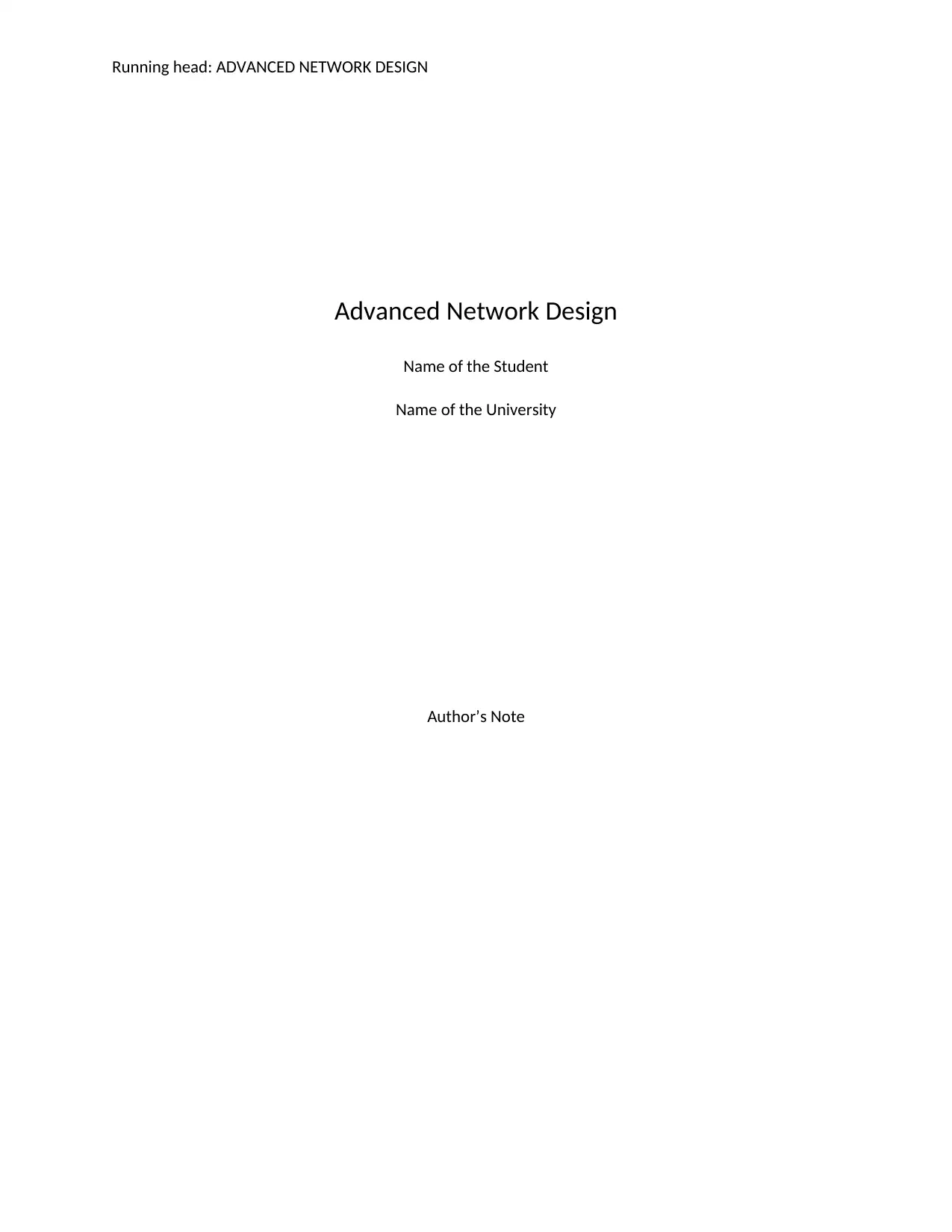
Running head: ADVANCED NETWORK DESIGN
Advanced Network Design
Name of the Student
Name of the University
Author’s Note
Advanced Network Design
Name of the Student
Name of the University
Author’s Note
Paraphrase This Document
Need a fresh take? Get an instant paraphrase of this document with our AI Paraphraser

1
ADVANCED NETWORK DESIGN
Table of Contents
PART I.............................................................................................................................................2
Questionnaires for Users............................................................................................................2
Questionnaires for Management................................................................................................2
Questionnaires for Other Staffs..................................................................................................2
Purpose of the Questionnaires...................................................................................................2
PART II............................................................................................................................................3
PART III...........................................................................................................................................4
Bibliography....................................................................................................................................6
ADVANCED NETWORK DESIGN
Table of Contents
PART I.............................................................................................................................................2
Questionnaires for Users............................................................................................................2
Questionnaires for Management................................................................................................2
Questionnaires for Other Staffs..................................................................................................2
Purpose of the Questionnaires...................................................................................................2
PART II............................................................................................................................................3
PART III...........................................................................................................................................4
Bibliography....................................................................................................................................6

2
ADVANCED NETWORK DESIGN
PART I
Questionnaires for Users
What are the application programs do you use in the workplace PC?
How frequently do you communicate with the other staffs connected in the network?
What type of communication do you use for communicating with the employees in the
organization?
Do you use wireless devices in the workplace for communicating with the other users in
the network?
Do you share files and documents in the network for increasing the productivity of the
organization?
Questionnaires for Management
How many departments are there in the organization that should be covered?
What are the expected benefits of the network solution proposed for the organization?
What is the time duration allocated for the completion of the network deployment?
Does any of the user groups needed to be blocked for accessing the sensitive resources
in the file server?
Questionnaires for Other Staffs
What is the purpose of using the internet?
Do you access multimedia files using the internet?
Is there any requirement to monitor the users connected in the network?
What organizational practices are involved in the organization for communicating with
the users?
Purpose of the Questionnaires
The questionnaires are developed for the stakeholders associated with the organization for
involving them in the requirement analysis phase and develop the network solution according to their
needs. The service that the users want should be identified by conducting the survey and it also helps in
identification of the behavior of the users. The questionnaires are of different types such as open ended
or close ended and it can be applied for the identification of the preference, facts and the behavior of
ADVANCED NETWORK DESIGN
PART I
Questionnaires for Users
What are the application programs do you use in the workplace PC?
How frequently do you communicate with the other staffs connected in the network?
What type of communication do you use for communicating with the employees in the
organization?
Do you use wireless devices in the workplace for communicating with the other users in
the network?
Do you share files and documents in the network for increasing the productivity of the
organization?
Questionnaires for Management
How many departments are there in the organization that should be covered?
What are the expected benefits of the network solution proposed for the organization?
What is the time duration allocated for the completion of the network deployment?
Does any of the user groups needed to be blocked for accessing the sensitive resources
in the file server?
Questionnaires for Other Staffs
What is the purpose of using the internet?
Do you access multimedia files using the internet?
Is there any requirement to monitor the users connected in the network?
What organizational practices are involved in the organization for communicating with
the users?
Purpose of the Questionnaires
The questionnaires are developed for the stakeholders associated with the organization for
involving them in the requirement analysis phase and develop the network solution according to their
needs. The service that the users want should be identified by conducting the survey and it also helps in
identification of the behavior of the users. The questionnaires are of different types such as open ended
or close ended and it can be applied for the identification of the preference, facts and the behavior of
⊘ This is a preview!⊘
Do you want full access?
Subscribe today to unlock all pages.

Trusted by 1+ million students worldwide
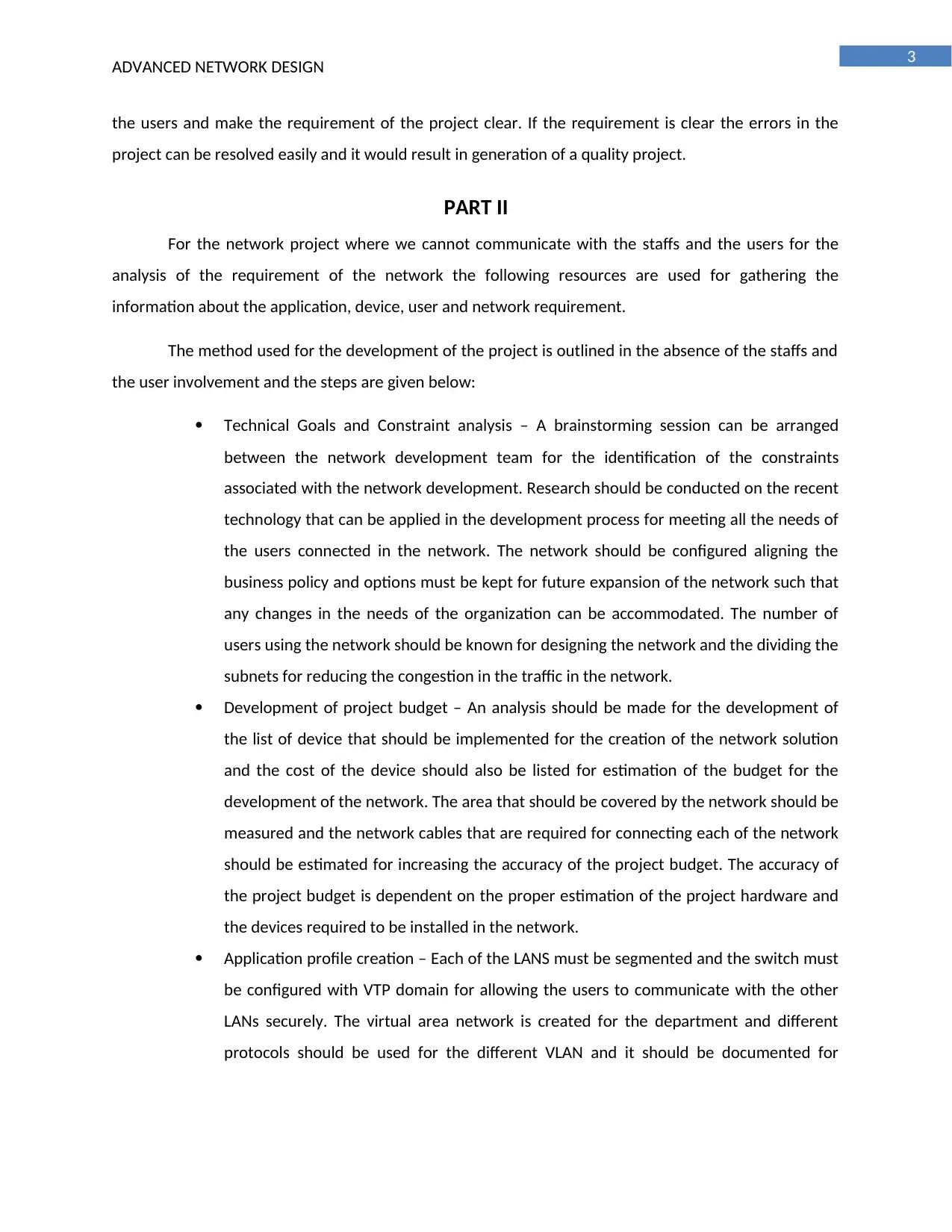
3
ADVANCED NETWORK DESIGN
the users and make the requirement of the project clear. If the requirement is clear the errors in the
project can be resolved easily and it would result in generation of a quality project.
PART II
For the network project where we cannot communicate with the staffs and the users for the
analysis of the requirement of the network the following resources are used for gathering the
information about the application, device, user and network requirement.
The method used for the development of the project is outlined in the absence of the staffs and
the user involvement and the steps are given below:
Technical Goals and Constraint analysis – A brainstorming session can be arranged
between the network development team for the identification of the constraints
associated with the network development. Research should be conducted on the recent
technology that can be applied in the development process for meeting all the needs of
the users connected in the network. The network should be configured aligning the
business policy and options must be kept for future expansion of the network such that
any changes in the needs of the organization can be accommodated. The number of
users using the network should be known for designing the network and the dividing the
subnets for reducing the congestion in the traffic in the network.
Development of project budget – An analysis should be made for the development of
the list of device that should be implemented for the creation of the network solution
and the cost of the device should also be listed for estimation of the budget for the
development of the network. The area that should be covered by the network should be
measured and the network cables that are required for connecting each of the network
should be estimated for increasing the accuracy of the project budget. The accuracy of
the project budget is dependent on the proper estimation of the project hardware and
the devices required to be installed in the network.
Application profile creation – Each of the LANS must be segmented and the switch must
be configured with VTP domain for allowing the users to communicate with the other
LANs securely. The virtual area network is created for the department and different
protocols should be used for the different VLAN and it should be documented for
ADVANCED NETWORK DESIGN
the users and make the requirement of the project clear. If the requirement is clear the errors in the
project can be resolved easily and it would result in generation of a quality project.
PART II
For the network project where we cannot communicate with the staffs and the users for the
analysis of the requirement of the network the following resources are used for gathering the
information about the application, device, user and network requirement.
The method used for the development of the project is outlined in the absence of the staffs and
the user involvement and the steps are given below:
Technical Goals and Constraint analysis – A brainstorming session can be arranged
between the network development team for the identification of the constraints
associated with the network development. Research should be conducted on the recent
technology that can be applied in the development process for meeting all the needs of
the users connected in the network. The network should be configured aligning the
business policy and options must be kept for future expansion of the network such that
any changes in the needs of the organization can be accommodated. The number of
users using the network should be known for designing the network and the dividing the
subnets for reducing the congestion in the traffic in the network.
Development of project budget – An analysis should be made for the development of
the list of device that should be implemented for the creation of the network solution
and the cost of the device should also be listed for estimation of the budget for the
development of the network. The area that should be covered by the network should be
measured and the network cables that are required for connecting each of the network
should be estimated for increasing the accuracy of the project budget. The accuracy of
the project budget is dependent on the proper estimation of the project hardware and
the devices required to be installed in the network.
Application profile creation – Each of the LANS must be segmented and the switch must
be configured with VTP domain for allowing the users to communicate with the other
LANs securely. The virtual area network is created for the department and different
protocols should be used for the different VLAN and it should be documented for
Paraphrase This Document
Need a fresh take? Get an instant paraphrase of this document with our AI Paraphraser
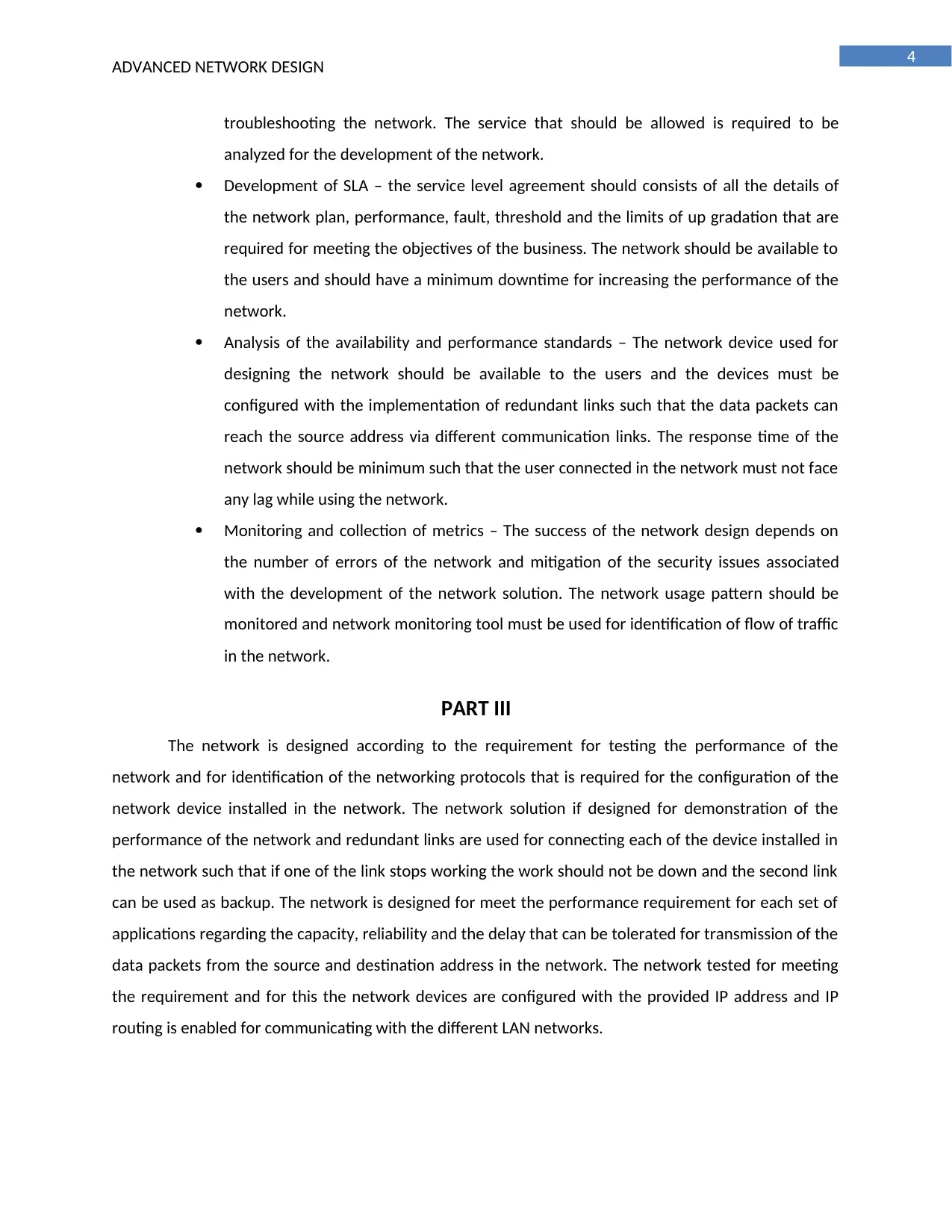
4
ADVANCED NETWORK DESIGN
troubleshooting the network. The service that should be allowed is required to be
analyzed for the development of the network.
Development of SLA – the service level agreement should consists of all the details of
the network plan, performance, fault, threshold and the limits of up gradation that are
required for meeting the objectives of the business. The network should be available to
the users and should have a minimum downtime for increasing the performance of the
network.
Analysis of the availability and performance standards – The network device used for
designing the network should be available to the users and the devices must be
configured with the implementation of redundant links such that the data packets can
reach the source address via different communication links. The response time of the
network should be minimum such that the user connected in the network must not face
any lag while using the network.
Monitoring and collection of metrics – The success of the network design depends on
the number of errors of the network and mitigation of the security issues associated
with the development of the network solution. The network usage pattern should be
monitored and network monitoring tool must be used for identification of flow of traffic
in the network.
PART III
The network is designed according to the requirement for testing the performance of the
network and for identification of the networking protocols that is required for the configuration of the
network device installed in the network. The network solution if designed for demonstration of the
performance of the network and redundant links are used for connecting each of the device installed in
the network such that if one of the link stops working the work should not be down and the second link
can be used as backup. The network is designed for meet the performance requirement for each set of
applications regarding the capacity, reliability and the delay that can be tolerated for transmission of the
data packets from the source and destination address in the network. The network tested for meeting
the requirement and for this the network devices are configured with the provided IP address and IP
routing is enabled for communicating with the different LAN networks.
ADVANCED NETWORK DESIGN
troubleshooting the network. The service that should be allowed is required to be
analyzed for the development of the network.
Development of SLA – the service level agreement should consists of all the details of
the network plan, performance, fault, threshold and the limits of up gradation that are
required for meeting the objectives of the business. The network should be available to
the users and should have a minimum downtime for increasing the performance of the
network.
Analysis of the availability and performance standards – The network device used for
designing the network should be available to the users and the devices must be
configured with the implementation of redundant links such that the data packets can
reach the source address via different communication links. The response time of the
network should be minimum such that the user connected in the network must not face
any lag while using the network.
Monitoring and collection of metrics – The success of the network design depends on
the number of errors of the network and mitigation of the security issues associated
with the development of the network solution. The network usage pattern should be
monitored and network monitoring tool must be used for identification of flow of traffic
in the network.
PART III
The network is designed according to the requirement for testing the performance of the
network and for identification of the networking protocols that is required for the configuration of the
network device installed in the network. The network solution if designed for demonstration of the
performance of the network and redundant links are used for connecting each of the device installed in
the network such that if one of the link stops working the work should not be down and the second link
can be used as backup. The network is designed for meet the performance requirement for each set of
applications regarding the capacity, reliability and the delay that can be tolerated for transmission of the
data packets from the source and destination address in the network. The network tested for meeting
the requirement and for this the network devices are configured with the provided IP address and IP
routing is enabled for communicating with the different LAN networks.
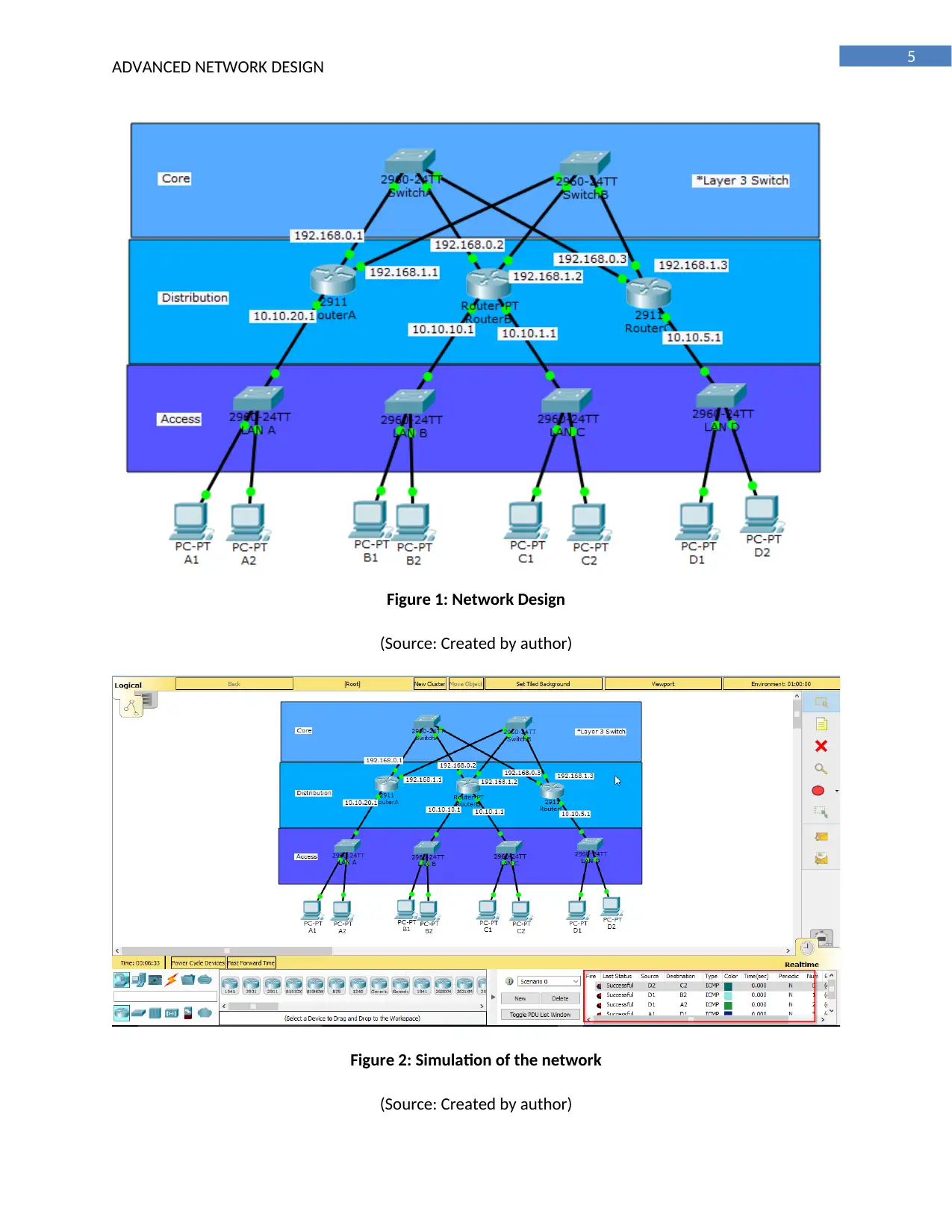
5
ADVANCED NETWORK DESIGN
Figure 1: Network Design
(Source: Created by author)
Figure 2: Simulation of the network
(Source: Created by author)
ADVANCED NETWORK DESIGN
Figure 1: Network Design
(Source: Created by author)
Figure 2: Simulation of the network
(Source: Created by author)
⊘ This is a preview!⊘
Do you want full access?
Subscribe today to unlock all pages.

Trusted by 1+ million students worldwide
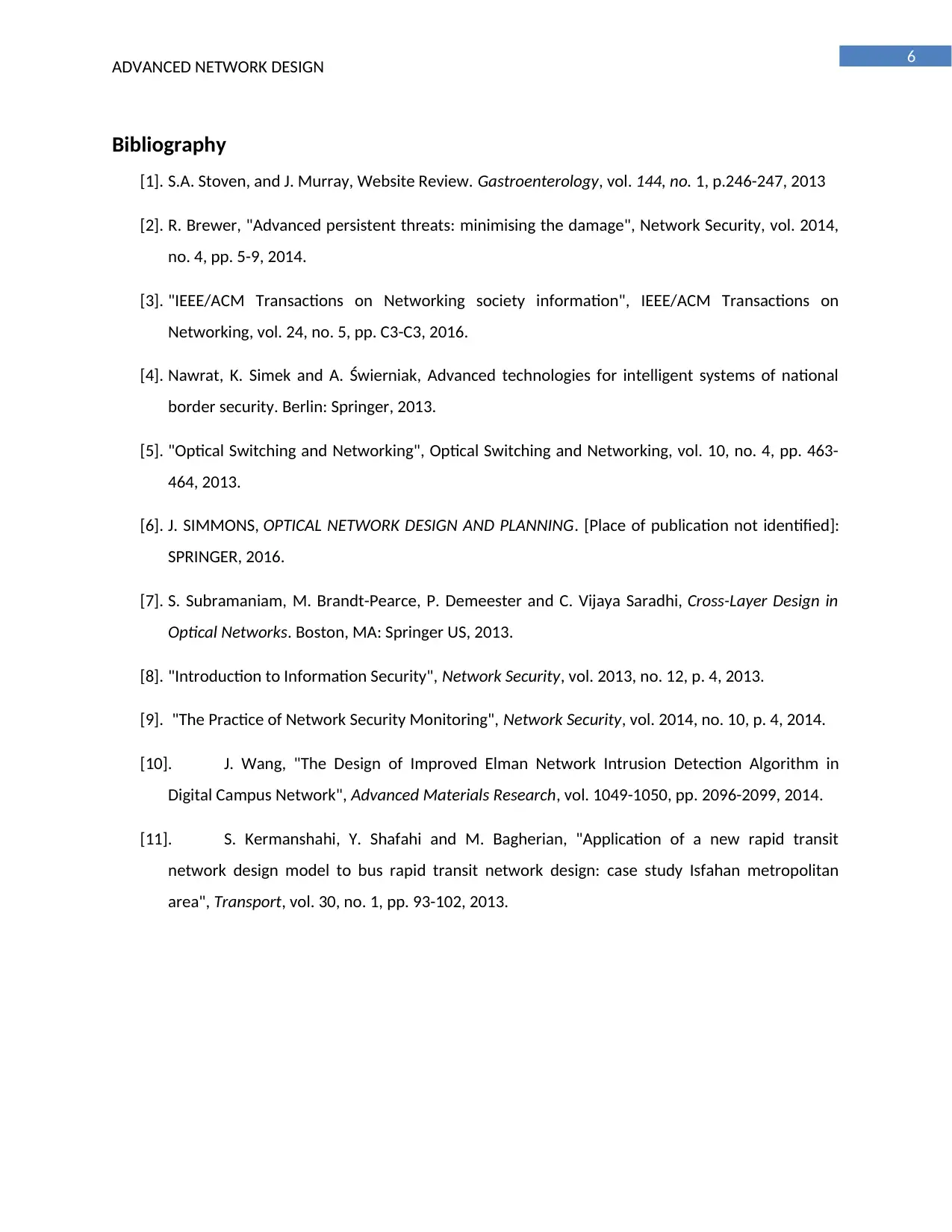
6
ADVANCED NETWORK DESIGN
Bibliography
[1]. S.A. Stoven, and J. Murray, Website Review. Gastroenterology, vol. 144, no. 1, p.246-247, 2013
[2]. R. Brewer, "Advanced persistent threats: minimising the damage", Network Security, vol. 2014,
no. 4, pp. 5-9, 2014.
[3]. "IEEE/ACM Transactions on Networking society information", IEEE/ACM Transactions on
Networking, vol. 24, no. 5, pp. C3-C3, 2016.
[4]. Nawrat, K. Simek and A. Ś wierniak, Advanced technologies for intelligent systems of national
border security. Berlin: Springer, 2013.
[5]. "Optical Switching and Networking", Optical Switching and Networking, vol. 10, no. 4, pp. 463-
464, 2013.
[6]. J. SIMMONS, OPTICAL NETWORK DESIGN AND PLANNING. [Place of publication not identified]:
SPRINGER, 2016.
[7]. S. Subramaniam, M. Brandt-Pearce, P. Demeester and C. Vijaya Saradhi, Cross-Layer Design in
Optical Networks. Boston, MA: Springer US, 2013.
[8]. "Introduction to Information Security", Network Security, vol. 2013, no. 12, p. 4, 2013.
[9]. "The Practice of Network Security Monitoring", Network Security, vol. 2014, no. 10, p. 4, 2014.
[10]. J. Wang, "The Design of Improved Elman Network Intrusion Detection Algorithm in
Digital Campus Network", Advanced Materials Research, vol. 1049-1050, pp. 2096-2099, 2014.
[11]. S. Kermanshahi, Y. Shafahi and M. Bagherian, "Application of a new rapid transit
network design model to bus rapid transit network design: case study Isfahan metropolitan
area", Transport, vol. 30, no. 1, pp. 93-102, 2013.
ADVANCED NETWORK DESIGN
Bibliography
[1]. S.A. Stoven, and J. Murray, Website Review. Gastroenterology, vol. 144, no. 1, p.246-247, 2013
[2]. R. Brewer, "Advanced persistent threats: minimising the damage", Network Security, vol. 2014,
no. 4, pp. 5-9, 2014.
[3]. "IEEE/ACM Transactions on Networking society information", IEEE/ACM Transactions on
Networking, vol. 24, no. 5, pp. C3-C3, 2016.
[4]. Nawrat, K. Simek and A. Ś wierniak, Advanced technologies for intelligent systems of national
border security. Berlin: Springer, 2013.
[5]. "Optical Switching and Networking", Optical Switching and Networking, vol. 10, no. 4, pp. 463-
464, 2013.
[6]. J. SIMMONS, OPTICAL NETWORK DESIGN AND PLANNING. [Place of publication not identified]:
SPRINGER, 2016.
[7]. S. Subramaniam, M. Brandt-Pearce, P. Demeester and C. Vijaya Saradhi, Cross-Layer Design in
Optical Networks. Boston, MA: Springer US, 2013.
[8]. "Introduction to Information Security", Network Security, vol. 2013, no. 12, p. 4, 2013.
[9]. "The Practice of Network Security Monitoring", Network Security, vol. 2014, no. 10, p. 4, 2014.
[10]. J. Wang, "The Design of Improved Elman Network Intrusion Detection Algorithm in
Digital Campus Network", Advanced Materials Research, vol. 1049-1050, pp. 2096-2099, 2014.
[11]. S. Kermanshahi, Y. Shafahi and M. Bagherian, "Application of a new rapid transit
network design model to bus rapid transit network design: case study Isfahan metropolitan
area", Transport, vol. 30, no. 1, pp. 93-102, 2013.
1 out of 7
Related Documents
Your All-in-One AI-Powered Toolkit for Academic Success.
+13062052269
info@desklib.com
Available 24*7 on WhatsApp / Email
![[object Object]](/_next/static/media/star-bottom.7253800d.svg)
Unlock your academic potential
Copyright © 2020–2025 A2Z Services. All Rights Reserved. Developed and managed by ZUCOL.




